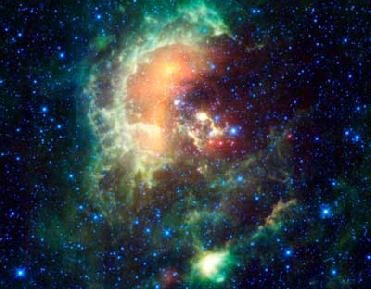
This image from WISE shows the Tadpole nebula. NASA/JPL-Caltech/UCLA Photo.
LOS ANGELES (BNS): NASA�s Wide-field Infrared Survey Explorer (WISE) has sent images of an asteroid marching across Tadpole Nebula.
The asteroid, called 1719 Jens, left tracks around the Tadpole Nebula. A second asteroid, called 1992 UZ5, was also observed cruising by, according to a news report by the NASA.
Tadpole nebula is a star-forming hub in the Auriga constellation about 12,000 light-years from Earth.
The tadpole region is full of stars as young as only a million years old. It is called Tadpole nebula because the masses of hot, young stars are blasting out ultraviolet radiation that has etched the gas into two tadpole-shaped pillars, called Sim 129 and Sim 130.
These "tadpoles" appear as the yellow squiggles. The knotted regions at their heads are likely to contain new young stars. WISE's infrared vision is helping to ferret out hidden stars such as these, as reported by the NASA.
The 1719 Jens asteroid, discovered in 1950, orbits in the main asteroid belt between Mars and Jupiter. The space rock, which has a diameter of 19 kilometers (12 miles), rotates every 5.9 hours and orbits the sun every 4.3 years.
The space telescope, WISE is on an all-sky survey, snapping pictures of the whole sky, including everything from asteroids to stars to powerful, distant galaxies.
 Previous Article
Previous Article Next Article
Next Article













The Indian Air Force, in its flight trials evaluation report submitted before the Defence Ministry l..
view articleAn insight into the Medium Multi-Role Combat Aircraft competition...
view articleSky enthusiasts can now spot the International Space Station (ISS) commanded by Indian-American astr..
view article